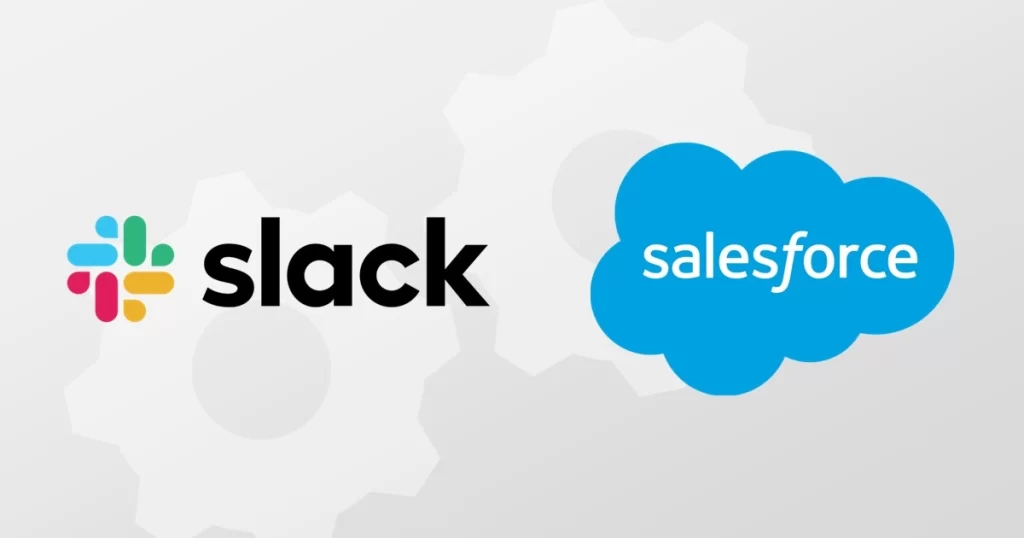The Salesforce Slack integration has reshaped the way businesses approach customer relationship management (CRM) by combining the world’s leading CRM platform with a top-tier collaboration tool. Salesforce’s acquisition of Slack in December 2020 for $27.7 billion was a strategic move aimed at creating a digital headquarters that facilitates seamless communication and collaboration within its CRM offerings. Over the past few years, this integration has proven to enhance productivity, streamline workflows, and foster deeper collaboration across teams, while enabling businesses to stay agile in a fast-paced, digital-first world.
This case study examines the motivations behind Salesforce’s acquisition of Slack, the integration of Slack into its CRM ecosystem, the competitive landscape, and the potential long-term impact on Salesforce’s market position.
Background of Salesforce and Slack
Salesforce
Founded in 1999 by Marc Benioff, Salesforce has grown to become a global leader in customer relationship management (CRM) software. It offers a suite of applications designed to help businesses manage sales, marketing, customer service, and commerce through cloud computing. Over the years, Salesforce has consistently expanded its product offerings, making strategic acquisitions such as Tableau (data analytics) and MuleSoft (integration software) to strengthen its position in the market.
Slack
Slack, founded in 2013, quickly emerged as a leading workplace communication platform. With its user-friendly interface, Slack revolutionized team collaboration by providing a digital workspace that consolidates team messaging, file sharing, and app integration. The platform became popular in remote work environments, supporting seamless communication across distributed teams.
Strategic Drivers Behind the Salesforce Slack Integration
The Salesforce Slack integration was born out of the need to provide businesses with a collaborative platform tightly integrated into their customer management systems. The acquisition was motivated by several key factors:
Enhancing Salesforce’s CRM Offering
Salesforce’s strength lies in its ability to help businesses manage customer relationships. However, the growing need for internal collaboration—particularly for distributed teams—presented an opportunity to integrate a powerful communication tool. By acquiring Slack, Salesforce could embed collaboration directly into its CRM platform, streamlining workflows, and making it easier for teams to manage sales pipelines, customer service cases, and marketing campaigns.
Competing with Microsoft Teams
The Salesforce Slack integration provided a direct response to Microsoft, which had been positioning its Teams product as a powerful collaboration tool within its Microsoft 365 suite. Microsoft Teams was also integrated with its own CRM platform, Dynamics 365. The acquisition of Slack allowed Salesforce to level the playing field, giving its users a best-in-class collaboration experience.
Creating a “Digital HQ”
The integration supported Salesforce’s broader vision of creating a “Digital HQ,” where all customer data, team communications, and app workflows are centralized. This concept became especially crucial in the wake of the COVID-19 pandemic, where remote work and digital collaboration tools became essential to business operations.
Impact of Salesforce Slack Integration
Streamlined Collaboration within CRM
The Salesforce Slack integration enabled users to collaborate directly within the Salesforce ecosystem. Slack channels became places where teams could share real-time updates, collaborate on deals, and resolve customer service issues quickly. For example, teams using Salesforce Service Cloud can now troubleshoot customer cases in Slack, where all relevant information is accessible, reducing resolution times and improving customer satisfaction.
Increased Productivity
With the integration, businesses experienced significant productivity gains. Slack allows users to create channels dedicated to specific customers, sales opportunities, or projects. Salesforce’s automation tools (such as Flow Builder) further augmented this by allowing users to automate repetitive tasks, like sending notifications or updating records, all within Slack. This eliminated time-consuming back-and-forths across different platforms and kept all team members on the same page.
Unified App Ecosystem
Salesforce Slack integration leveraged the thousands of apps already available on Slack, including integrations with Google Workspace, Zoom, and other tools. This allowed teams to work seamlessly across various platforms, accessing all their necessary tools from within the Slack interface while keeping Salesforce data at the center of customer interactions. Slack’s open API and Salesforce’s AppExchange provided even more opportunities for businesses to customize their workflows.
Enhanced Remote Work Capabilities
The integration addressed the needs of remote and hybrid workforces by providing teams with the flexibility to work from anywhere while maintaining the same level of productivity and communication. Salesforce’s Customer 360 platform, which provides a single source of truth for customer data, became even more powerful with Slack, enabling teams to collaborate in real-time regardless of their location.
Competitive Landscape
Salesforce vs. Microsoft
The Salesforce Slack integration placed Salesforce in a stronger competitive position against Microsoft, whose Teams product had been growing rapidly in the collaboration space. While Microsoft offered the benefit of integrating its suite of productivity tools with its CRM platform, Salesforce’s integration of Slack allowed for a more flexible, user-friendly approach that appealed to companies using a wide range of apps. The success of the Salesforce Slack integration became a key differentiator for Salesforce in retaining its lead in the CRM market.
Zoom and Other Competitors
Slack’s integration with video conferencing tools like Zoom helped Salesforce cater to businesses that rely on real-time communication for remote work. While Zoom is not a direct competitor to Salesforce, its collaboration tools were seen as complementary, and the tight integration with Slack enhanced the overall user experience. Similarly, Slack’s existing partnerships with Google Workspace and other popular tools helped Salesforce maintain a broad ecosystem that many organizations already used.
Challenges and Risks
While the Salesforce Slack integration has brought numerous benefits, it also presents several challenges:
- Adoption and Integration Complexity: For existing Salesforce customers, incorporating Slack into their workflows required careful planning and adoption strategies. Businesses needed to ensure that teams were trained on how to maximize the integration, and that the transition to using Slack as a primary collaboration tool was smooth.
- Cultural Integration: Merging Slack’s startup culture with Salesforce’s large enterprise structure required alignment on long-term goals. Both companies needed to ensure that their teams worked well together to drive innovation and maintain a customer-centric focus.
- Competition from Microsoft Teams: Despite the advantages of the Salesforce Slack integration, Microsoft Teams remained a formidable competitor due to its deep integration with Microsoft 365 and Dynamics 365.
Outcomes and Long-Term Impact
Slack’s Impact on Salesforce Revenue Growth
Salesforce’s acquisition of Slack in 2021, valued at approximately $27.7 billion, marked a significant shift in the workplace collaboration and CRM landscape. Through the Salesforce Slack Integration, the company integrated Slack into its Customer 360 platform to create a “Digital HQ” that connects employees, customers, and partners in a unified workspace. This Salesforce Slack Integration enabled businesses to collaborate more effectively across distributed teams while keeping customer data and communication within a single ecosystem. With over 12 million daily active users, Slack’s contribution to Salesforce’s annual revenue, which reached $31.35 billion in 2023, has been substantial. The Salesforce Slack Integration not only strengthened Salesforce’s competitive position against Microsoft Teams but also enhanced its capacity to offer seamless, multi-app integration to over 150,000 enterprise clients.
Growth in User Adoption
Since the acquisition, Slack’s daily active users have increased, with Salesforce reporting that more than 90% of its enterprise customers now use Slack as part of their CRM processes. This widespread adoption underscores the success of the Salesforce Slack integration in becoming a critical tool for business collaboration.
Salesforce’s Vision for the Future
Salesforce has continued to push forward its vision of the Digital HQ, with Slack positioned as the central hub for communication and collaboration across all Salesforce products. As businesses increasingly rely on cloud-based solutions, the Salesforce Slack integration is set to play a critical role in how companies manage customer relationships and operate efficiently in a digital-first world.
Conclusion
Salesforce’s acquisition of Slack was a bold move aimed at addressing the evolving needs of businesses in a rapidly changing digital landscape. By integrating Slack’s collaboration tools into its CRM offering, Salesforce enhanced its ability to provide a more comprehensive, productivity-driven solution for its customers. While the success of this acquisition ultimately depends on how well Salesforce can drive user adoption and execute its integration strategy, the potential impact on the CRM and collaboration markets is significant.
Key Takeaways
- Strengthening CRM with Collaboration: Salesforce enhanced its CRM by integrating Slack’s collaboration tools, making communication and data sharing more efficient.
- Positioning Salesforce as a Digital HQ: Slack became central to Salesforce’s vision of a “digital HQ,” catering to growing remote work demands.
- Competitive Response to Microsoft Teams: With Slack, Salesforce strengthened its competitive stance against Microsoft Teams by offering a solid alternative in the collaboration space.
- Facilitating Remote Work: Slack’s tools help distributed teams collaborate more effectively, addressing the shift to remote and hybrid work.
- Challenges in Adoption: Salesforce faces challenges in integrating Slack seamlessly and ensuring user adoption with minimal friction.
- Potential for Market Leadership: If successful, Salesforce could lead in both CRM and digital transformation, offering a comprehensive business solution.
In the long term, Salesforce’s vision of a unified digital workspace, powered by Slack, could redefine how businesses think about collaboration and customer management, positioning Salesforce as a key enabler of digital transformation across industries.




